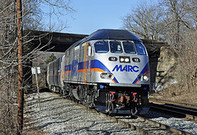MARC works on improvements despite lean budget

By Zoltan Connell on Flickr.
In 2007, the Maryland Mass Transit Administration made its long-term Growth and Investment Plan for MARC commuter train service public. In spite of frequent criticism for tardiness and equipment failures, the agency has made remarkable strides towards more frequent, reliable and appealing service on its three lines.
The plan calls for the addition of new trains and enhancing the reliability of existing trains. It envisions frequent, 7-day-a-week service on all three lines by
2035, made possible by the acquisition of new locomotives and railcars and capacity upgrades to the host railroads.
As always, funding is the main obstacle. To this end, MTA and the Maryland Department of Transportation continue to work closely with members of the state’s Congressional delegation and the Maryland General Assembly to find sources for more reliable and appropriate funding for MARC capital improvements.
MDOT has made this a priority in its efforts to influence Congress’s work on a surface transportation reauthorization bill. Thankfully, Governor O’Malley and his administration remain committed to maintaining current service levels and to expanding service as the revenue picture improves.
The Plan has already resulted in one early improvement: a new rush-hour Washington-Baltimore Penn Line train that was added in 2008, substantially reducing the number of standees on the most crowded evening run. An additional late night round-trip added at the same time, however, was soon withdrawn due to a budget shortfall.

One of MARC’s new, fuel-efficient MP36 locomotives on the Camden Line. Photo by John H. Gray on Flickr.
Another noticeable improvement for many passengers has been the replacement of all 19 of the older GP40 locomotives from the 1970s. MTA ordered 26 new MP36 engines, at least 18 of which are already in service, which should improve reliability and allow for service increases when money can be found.
13 bi-level cars have been added to the MARC fleet in the past two years, acquired from neighboring Virigina Railway Express. MARC now operates more passenger cars than at any previous time in the agency’s history.
The agency has also been working to improve customer comfort. Seat cushions in all 63 bi-level cars have been replaced. The appearance of coaches should also be improving, as all cars’ exteriors are now being hand-washed every 180 days when Amtrak inspects them.
Crews are beginning to install a new passenger information system at each MARC station, which will visually display GPS-based estimated arrival times for the next two trains, and make computer-generated audio announcements as a train approaches. Installation of this system on the Brunswick Line will be completed this winter, with the Penn and Camden Lines expected to follow by the summer. Amtrak’s New Carrollton and Aberdeen stations, where Penn Line trains call, already have such systems.
Expanded parking is in place at Perryville, Aberdeen, Martin Airport and Point of Rocks, and work has begun to expand parking at West Baltimore.
MTA and Amtrak have agreed to terms laying the groundwork for the establishment of weekend Penn Line service, but further action was precluded by state budget constraints. The capital improvements and agreement with CSX necessary for additional Camden Line service have been funded, but there are no operating funds available to add one new round-trip which could otherwise start immediately.
MTA and CSX have agreed on near-term capacity improvements for the Camden and Brunswick Lines, some of which began in 2010. MTA plans to pursue the triple-tracking of portions of both lines incrementally as funding becomes available. Recovery Act-funded preliminary design work for a fourth track between Halethorpe and Odenton has also begun.
Recently-completed work by Amtrak now allows two MARC trains to arrive or depart simultaneously at Washington Union Station. Beginning in 2011, MARC plans to move trains to near Martin Airport for storage to free space at Baltimore Penn Station.
MTA has started to prepare specifications for a procurement of new cars in 2014, but is also exploring opportunities to acquire equipment as part of another agency’s contract.
Aside from securing dedicated funding, the agency’s other major priorities are to acquire Baltimore’s Riverside shop from CSX and construct a new maintenance facility for MARC equipment.
Given the severe constraints it has had to operate under, and the mechanical deficiencies that have plagued its service, MTA has done a remarkable job of making meaningful improvements.
All Marylanders and the entire capital region have a stake in ensuring that MTA gets the resources it needs to bring the MARC Growth and Improvement Plan to fruition. Continue to urge your federal representatives and, if you live in Maryland, your state legislators to come up with a dedicated funding source for safe, reliable and affordable regional rail and transit service.
